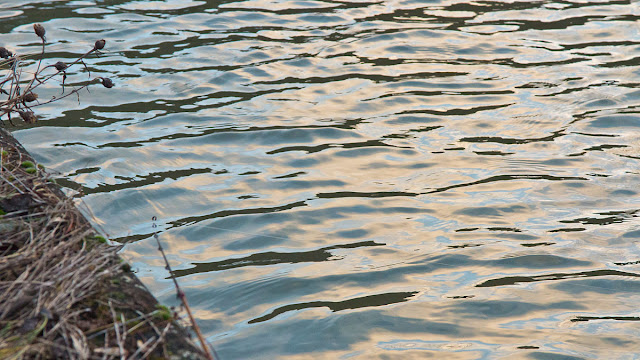WHAT'S REALLY HAPPENING?
With our recent lack of success playing away from home, we decided to return to a more reliable piece of canal. We've both been successful here but it felt to me like all the best fishing has come from one exact spot opposite a prominent feature on the far bank. It was Pete's turn in the hotspot today, so I set up ten yards to his left.
As we so often do, we employed different techniques, he floatfished, I just pinched 3BB on the line and fished bread on a quivertip. We both put in a fair amount of groundbait before starting, mine containing hemp, Pete's, dead maggots and chopped worm. We both had bites immediately and frequently between 8am and 10am, when his stopped altogether. Although I was still getting small bites, I decided to and move ten yards to his right in search of better opportunities but that was a mistake. Having done so I never had another touch either.
His were bold and pretty easy to hit producing three bream between 1-8 and 1-12, a 12 oz perch and two or three small fish. Mine on the other hand were sharp, small, but definite bites that resulted in one small skimmer. His came mostly on worm although he did catch one on bread I believe. I only used bread. The difference between the swims was stark and somewhat baffling, and raises many questions. How many fish are down there, why so few and why such trivial bites on bread when it usually works extremely well here, how tightly are those better fish shoaling?
In the context of that whole stretch of canal, this area is wider and concrete sided which could make this a winter holding area. Within the swim. There are no features in or overhanging the water and yet the bulk of the fish have all come from one spot , easily located because of a post on the far bank. It's another one of those puzzles that make canal angling so absorbing and here's another question for anyone who cares to offer an opinion.
The angler on most medium sized and large rivers, can generally expect to be in with a chance of getting bites on and off all day. Likewise on most stillwaters, bites can come at any time. Not canals though it is extremely unusual for sport to continue after 10.30 in the morning, at least until the evening. Perch are a bit more obliging than other silver fish in winter, at least they are in some places, but that's it. The obvious reason behind this is the effect of boat traffic, colouring the water, dispersing the feed and probably scattering the shoals. It's just that this stretch has had almost zero traffic since November and passage to boats is not expected to be reinstated until march.
So, is it because it's a narrow waterway, the same effect is apparent on smaller rivers, and catching fish causes too much disturbance? Is it because the shoals are smaller than we think and we catch too great a percentage or choke them off by putting in too much feed? Are they too mobile and just move off or are they still just sitting there twiddling their fins and ignoring our efforts? Most importantly, can we do anything to improve our chances or should we just throw in the towel at 11am and follow the scent of the barmaid's apron?



Comments
Post a Comment